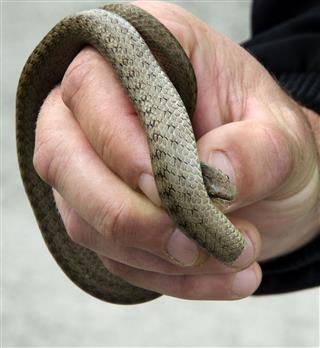
The issue of keeping exotic pets is a divisive one. Animal rights activists are up in arms over it, while there is also no consensus among experts. This PetPonder article will shed some more light on this debate.
Did You Know?
By some estimates, a yearly average of 3.5 people die from exotic animal attacks. Since this number also includes deaths occurring in zoos, this number is not worrisome at all for exotic pet owners, considering the statistical negligibility of 3.5 people among an American population of more than 316 million (as of 2013).
Everyone (well, most of us) loves pets. While most of us limit that love to more conventional animals such as dogs, cats, budgerigars, and fish, there are many who extend it to animals such as snakes and chimpanzees. This gives rise to the debate over keeping exotic wild animals as pets.
In an age of the rising influence of various animal rights movements, the ever-growing trade in exotic pets is an obvious culprit, and regularly finds itself under the microscope. The reason why the debate over exotic pets has rumbled on for so long is that there is no simple answer. There are equally sound arguments on both sides of the debate, and a conclusion is hard to reach. Here’s an attempt to do just that.
Pros and Cons of Keeping Exotic Pets
One of the main problems in settling this debate is the variable definition of ‘exotic pets’. By the strict definition, even non-native animals that are bred locally and legally, and not taken from their natural environment, are ‘exotic’. Similarly, while the term ‘exotic animals’ usually sets alarm bells ringing, not all exotic animals are a threat to society. Pythons and chimpanzees, primarily, are the culprits in pet attacks, and such animals are obviously dangerous, but the extremely harmless and positively cute sugar gliders and crested geckos are not even dangerous for infants, let alone adult, sensible pet owners.
Albeit there are such confusions, here are some points about the pros and cons of keeping exotic pets.
Pros of Keeping Exotic Pets
This section deals with exotic animals of low intelligence and low risk. Such animals include several reptiles, rodents, frogs, unconventional felines, such as the serval, fennec foxes, guinea pigs, etc. Dangerous and endangered animals such as chimpanzees, pythons, big cats, crocodiles, etc., do NOT belong in a domestic environment, and shouldn’t be kept as pets. More explanation of their situation is provided further on.
★ Low Upkeep
Most exotic pets are low-maintenance―at least in comparison to dogs and cats. Lizards, frogs, spiders, and even snakes require basic and cheap shelters, infrequently (to an extent) provided cheap food, and minimal veterinary care. An empty aquarium with a bit of bedding and a few rocks will do just fine. Some species may need some branches and live plants. So, they are perfect for the typical urban pet owner, who can easily house these animals in an average apartment. On the flip side, though, these pets won’t be as affectionate as dogs. They will recognize you and tolerate your handling, and a few may go so far as seeking out your attention.
★ Perfect for Busy Owners
Unlike dogs, lizards don’t need to be taken out for a walk. Unlike cats, snakes don’t need to have their head scratched. Unlike lovebirds, frogs don’t need you to keep them company. Most exotic pets are fairly independent, and don’t need to be shown constantly that their owner does, indeed, love them to death. Enough handling to keep them social and familiar with you will do.
★ Hypoallergenic
Many animal lovers can’t have a conventional pet because they are allergic to dog or cat dander, or feathers. On the other hand, reptiles, frogs, etc., don’t have hair or feathers, and are thus, perfect for these pet seekers. Exotic mammals may cause some allergies, of course, but reptiles work fine with everybody.
★ Incredibly Safe
It is a tragedy that people think of a tiger or a cougar when they think of ‘exotic animals’. If we take the dangerous wild animals out of the equation, how many deaths do you think pet lizards, frogs, snakes (including the scarily named boa constrictor and the much-maligned African rock python), spiders (including poisonous spiders) guinea pigs, wild cats (not big cats), wallabies, muntjacs, etc., have caused? In America, at least, the total is much less than the number of fatal attacks by dogs! That’s right, your neighbor’s Doberman Pinscher is likelier to come at you than your creepy neighbor’s boa constrictor.
Neglected, harassed, or mistreated animals will seek to fulfill their basic needs, and unfortunately some do possess the tools to kill humans quite easily, but an unprovoked intentional attack from an aggressive exotic pet is virtually unheard of. It is due to the emotional appeal by media that these animals get a bad rap, not due to statistics.
★ Wild Populations are Unaffected
The converse of this point will also appear in the ‘cons’ section, due to the variable definition of ‘exotic animals’. Taking a chimpanzee from its natural habitat in Africa is not commendable due to the adversities faced by and the declining number of wild chimpanzees, but getting an ‘exotic’ pet from a breeding program in your own country has no effect whatsoever on the animal’s wild populations. Numerous animals, particularly snakes and lizards, are part of breeding programs in the U.S.
Moreover, most exotic animals are simply so abundant in their wild environment that a legal and well-regulated pet trade doesn’t have any adverse effect on their population. Animals such as the fennec fox, the muntjac deer, wallabies, anteaters, and most lizards, geckos, and snakes are thriving in their wild habitat, and don’t need conservation efforts to increase their wild populations. The emotional argument of taking an animal away from its ‘home’ is a purely emotional argument, and is a matter of your sensitivity.
Cons of Keeping Exotic Pets
As you can see, there is simply no rational argument against having pets that won’t kill you (unless you give them more than sufficient reason to) and that don’t affect the wild population. However, there is a huge flip side to the exotic pet trade, which we will now explore.
✖ The Illegal Pet Trade
As said before, the wild populations of some exotic pets are severely affected by the pet trade. Due to this, bans have been imposed on the trade of numerous animals, but the illegal pet trade continues to fester in many wildlife-rich regions of the world. Animals such as big cats (none of which is in rude health at the moment) and many primates need all the help we can provide for their wild populations to flourish. The illegal pet trade is a big contributor to the reducing numbers of some species.
The damage is not just limited to the actual ‘sale’ of the animal. The transport, often to places very far from the animal’s native region, can be taxing. The animal is stored in torturous containers, and is very rarely looked after during the travel. Since the collective benefit gained by the transactions is much more than the expenses of capturing the individual animal, it is often ignored and mistreated until it finds a patron.
This poaching is also harmful for the animal’s native environment, since the loss of an element in the local food web can wreak havoc upon it.
✖ Negligent Owners
Most animals that can be kept as pets, perhaps excluding crocodiles and pythons, have no natural aggression towards humans. Even big cats are timid and scared of humans, and ‘maneaters’ are, thus, not very common. Unfortunately, the nature of the pet trade means that many patrons end up buying cute-looking cubs that grow to become larger and stronger than they had anticipated. This disillusion can then result in negligence and mistreatment of the pet, which can cause horrific tragedies due to developed, rather than instinctual, aggression. Sometimes the pet is simply abandoned, which either causes it to perish in an unfamiliar environment, or it becomes a nuisance by being successful in an environment that has no niche for it.
The numerous success stories of keeping such dangerous animals as pets show that with sufficient care and attention, even these animals can be successfully raised in a human society, and that the owner is usually to blame for a pet’s misconduct.
✖ Intelligence and Highly Developed Instincts
Higher predators such as big cats and crocodiles have highly developed predatory instincts that can’t be wiped out very easily. Though adult humans don’t always present a clearly accessible target, this makes the animals an innate threat not just to their owner, but his visitors, his neighbors, and especially their more conventional pets. Supporters of the exotic pet trade argue that dogs were feral before they were domesticated, but that argument ignores the thousands of years of domestication and selective breeding (try petting a wild pack of gray wolves). After hundreds of rounds of selective breeding, even tigers, lions, and bears could become docile and affectionate towards humans, but until then, they don’t belong in your house, just as much as you don’t belong in their jungle.
✖ Contagious Diseases
Though this is rare, exotic animals may act as vectors to diseases that can start an epidemic in their introduced locality. Thanks to the inability of many pathogens to cross species barriers, this problem has a natural, but partial remedy. However, diseases such as hepatitis A and B, rabies, and salmonella are some commonly observable diseases that can be transmitted by exotic reptiles and mammals.
Conclusion
Taking into account all the points mentioned above, it would seem that as a purely rational argument, keeping docile exotic pets born in breeding programs is acceptable. It doesn’t harm the animal or its native environment in any way (if anything, it may raise awareness about it on a small scale), and it’s not dangerous for the animal or the owner. Similarly, keeping dangerous and intelligent pets has very obvious risks, and thus, should be disallowed.
The rational argument is, however, often cast aside as emotions take priority. As mentioned before, the misrepresentation of the term ‘exotic pets’ by animal welfare/animal rights movements and the media has resulted in a misinformed public opinion. Many people are―understandably, I admit―against the very notion of keeping exotic pets, since they think those animals were ‘meant to be in the wild’. This is a perfectly understandable personal opinion, but not so much so when it comes to deciding a public policy.
Using emotional terms such as ‘snatching an animal from its home’ may win your organization the uninformed public’s support, but it is entirely misleading. Most animals are extremely adaptable, and as long as there is no radical change in the environment, they simply don’t care whether they grow up in their native environment or in a suburban home in America. Unlike humans, most animals simply don’t have the intelligence necessary for such complex emotions. Humans are among the very few animals (arguably only animal) intelligent enough to harbor such sensitivities and predispositions, and enforcing our paradigm onto animals is unfair to both humans and animals.
All in all then, by all means, keep non-aggressive exotic pets bought from breeder programs, but make sure you can take care of them as long as they need it!















